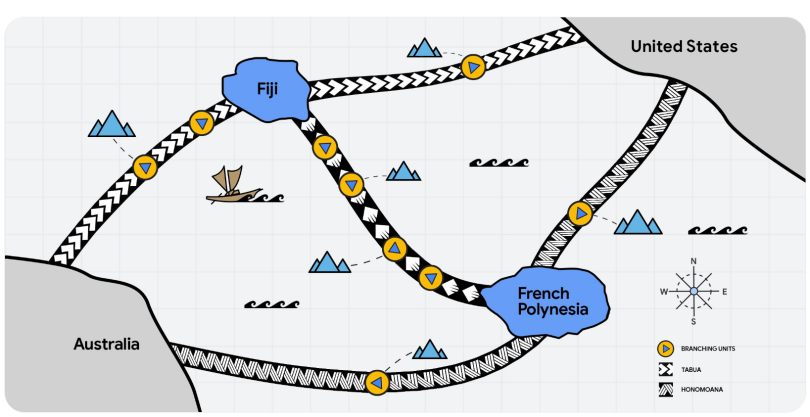On 25 October 2023, the United States government announced funding for a new undersea internet cable initiative for Pacific Island countries. Initial responses to the announcement have been positive – at least the ones made publicly.
The announcement was made by President Biden during an official visit to the US by Australian Prime Minister Albanese. Australia and the US together intend to invest US$65 million (approximately A$100 million). In fact, the bulk of the total (US$50 million) will come from Australia. The US component builds on a commitment of US$3 million a month earlier for a feasibility study.
A striking aspect of the announcement was that the US technology company Google was named as a major player in the new cable development. In a piece put out by Google on the same day, it was explained that the project will consist of two new cables. Both will run between the US and the east coast of Australia. A cable named Honomoana will land in French Polynesia, while a cable called Tabua will land in Fiji. In addition, there will be a cable connecting French Polynesia and Fiji.
Aside from French Polynesia and Fiji, the intention is for the cable project to allow connection to other countries through branching units that will come out from the main two cables. Which Pacific countries will benefit? The White House announcement referred to branching units for the Federated States of Micronesia, Kiribati, Marshall Islands, Nauru, Papua New Guinea, Solomon Islands, Timor-Leste, Tuvalu and Vanuatu. Tuvalu has never had a cable connection. The Google announcement did not specify which other countries will be connected, aside from French Polynesia and Fiji.
A key point is that this donor initiative does not include mention of funding for submarine cable landing stations, beach manholes, or any other equipment or resources necessary to connect the extra nine countries listed. It seems that the funding is to provide for the possibility of connection at a later date, by adding branching units to the main cables. If that is the case, the branching units will lie on the ocean floor until such time as arrangements are made for them to connect.
It is worth noting that connectivity options vary substantially between Pacific Island countries. Taking into account cables that had already been announced prior to this initiative, a small number of countries and territories have no cable connection (Norfolk Island, Pitcairn Islands and Tuvalu), some have one or two cables, and a small number have more than two (Fiji, Guam, Hawai‘i and Samoa).
So, what have been the reactions to the announcement? It has been welcomed by the Prime Minister of Fiji, Sitiveni Rabuka, who wrote on X (formerly Twitter) that it marks “a significant step in the advancement of digital infrastructure in the Pacific region”. French Polynesia President Moetai Brotherson also welcomed the move, suggesting it is “turning French Polynesia into a new Pacific internet hub”. Mihai Sora of the Lowy Institute commented that it is “a good move by the US and Australia”.
But how do local telecommunication companies, other cable laying entities and existing cable operators feel about it? This project aims to increase access to the internet for people, businesses and governments in Pacific countries. Many Pacific nations have small populations and economies compared to countries in Asia and elsewhere. Could subsidies for branching units have outsized impacts in small markets that may lead to some existing companies struggling or even folding? It is conceivable that there could be negative impacts on local companies if the project subsidies erase or decrease their competitive advantage. If any existing operators close up shop, could locals be left no better off in terms of consumer choices? Are there concerns from industry players that have not yet been made public?
Questions remain about whether the countries listed by the White House will be connected. Will local operators have the chance to bid for participation in those cabling systems through a fair process? And how was Google chosen? Was there a thorough and transparent tender process? It has been suggested by Reuters that this is an expansion of an “existing commercial project by Google”. If that is the case, it may be an instance of two agile governments seizing the opportunity to add branching units to a cable project that was already in its planning phases. On the other hand, if there was no open tender process, it could be argued that this was an unfair process because other companies did not have a chance to submit proposals.
There are also questions about the financing. The majority of the money (US$50 million) is to come through the Australian Infrastructure Financing Facility for the Pacific. Will that be in the form of a grant or a loan? If it is a loan, who is expected to pay it back and under what terms?
To what extent did the announcement represent an attempt to counter China’s influence in the Pacific region? Mihai Sora sees the project in that light, arguing that “the US and Australia are offering an alternative to China’s initiatives in the digital and telecommunications sector”. It may be that this follows a pattern of earlier Pacific cable projects in which China seemed to be a factor influencing decision making. On the other hand, this may have nothing to do with China and simply be about long-term partners of Pacific Island countries trying to help to improve connectivity.
Disclosure
This research was supported by the Pacific Research Program, with funding from the Department of Foreign Affairs and Trade. The views are those of the author only.



Indeed, it is all in making the branches operational. Substantial know-how, and further financing will be required. We are not there yet, but all in all it seems a step in the right direction.